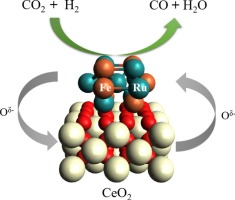Journal of CO2 Utilization ( IF 7.2 ) Pub Date : 2018-05-28 , DOI: 10.1016/j.jcou.2018.05.024 Christopher Panaritis , Mahesh Edake , Martin Couillard , Raha Einakchi , Elena A. Baranova

|
Utilization of CO2 through the reverse water gas shift (RWGS) reaction is a promising solution in managing greenhouse gas emissions. Here, we used the RWGS reaction to evaluate the catalytic conversion of CO2 over Ru-Fe nanoparticles supported on samarium-doped ceria (SDC) support. Catalysts of different RuxFe100-x compositions (x = 100, 80, 45, 20, 0 at.%) have been studied under steady-state conditions in a packed bed reactor in the temperature range 300–800 °C to determine their catalytic activity and selectivity towards CO. The metal-support interaction (MSI) effect for SDC was evaluated to determine its promotional behavior for the RWGS reaction. The catalyst was characterized using TEM, TGA, and ICP-ES techniques. Among all investigated catalysts, Ru45Fe55/SDC (2 wt.%) displayed the overall best activity and CO selectivity. A stability test of 100 h at 650 °C confirmed an excellent stability of the Ru45Fe55/SDC catalyst. Overall, the use of Ru45Fe55/SDC (2 wt.%) is a promising catalyst in the utilization of CO2, reaching a maximum CO yield of ∼47.5% at 800 °C and 100% CO selectivity above 500 °C. Furthermore, Ru45Fe55 (2 wt.%) nanoparticles were deposited on un-doped CeO2 and doped ceria: Gd-CeO2, Y2O3-CeO2, as well as yttria-stabilized zirconia (YSZ) and carbon supports. Contrary to carbon support, all catalysts containing oxygen conducting-ceramic supports displayed 100% selectivity to CO at temperatures above 600 °C, which can be attributed to the synergistic relationship between Ru-Fe nanoparticles being promoted through the MSI and thermally induced migration of promoting ionic species (Oδ−) from oxygen conducting ceramics to the nanoparticles.
中文翻译:

对基于二氧化铈的载体在RuFe纳米粒子上进行反向水煤气变换反应的作用的见解
通过反向水煤气变换(RWGS)反应利用CO 2是管理温室气体排放的有前途的解决方案。在这里,我们使用RWGS反应来评估CO 2在eria掺杂二氧化铈(SDC)载体上负载的Ru-Fe纳米粒子上的催化转化。不同Ru x Fe 100-x的催化剂在稳态条件下,在填充床反应器中,于300–800°C的温度范围内,对组成(x = 100、80、45、20、0 at。%)的化合物进行了研究,以确定它们的催化活性和对CO的选择性。评估了SDC的金属-载体相互作用(MSI)效应,以确定其对RWGS反应的促进行为。使用TEM,TGA和ICP-ES技术对催化剂进行了表征。在所有研究的催化剂中,Ru 45 Fe 55 / SDC(2 wt。%)显示出总体最佳活性和一氧化碳选择性。在650°C下100 h的稳定性测试证实了Ru 45 Fe 55 / SDC催化剂具有出色的稳定性。总体而言,使用Ru 45 Fe 55/ SDC(2 wt。%)是利用CO 2的有前途的催化剂,在800°C时的最大CO收率达到〜47.5%,在500°C以上时CO的选择性达到100%。此外,Ru 45 Fe 55(2 wt。%)纳米颗粒沉积在未掺杂的CeO 2和掺杂的二氧化铈:Gd-CeO 2,Y 2 O 3 -CeO 2上以及氧化钇稳定的氧化锆(YSZ)和碳载体。与碳载体相反,所有含氧导电陶瓷载体的催化剂在高于600°C的温度下均表现出对CO的100%选择性,这可归因于通过MSI促进的Ru-Fe纳米颗粒与促进反应的热诱导迁移之间的协同关系。从导氧陶瓷到纳米粒子的离子物种(Oδ-)。









































 京公网安备 11010802027423号
京公网安备 11010802027423号